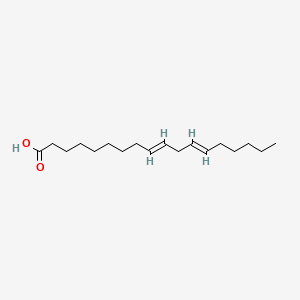| MeSH term | MeSH ID | Detail |
|---|---|---|
| Olfaction Disorders | D000857 | 17 associated lipids |
| Hypoxia | D000860 | 23 associated lipids |
| Aortic Diseases | D001018 | 11 associated lipids |
| Arrhythmias, Cardiac | D001145 | 42 associated lipids |
| Arteriosclerosis | D001161 | 86 associated lipids |
| Arteriosclerosis Obliterans | D001162 | 8 associated lipids |
| Ascites | D001201 | 25 associated lipids |
| Autoimmune Diseases | D001327 | 27 associated lipids |
| Cholestasis, Extrahepatic | D001651 | 7 associated lipids |
| Biliary Atresia | D001656 | 4 associated lipids |
Linoelaidic acid
Linoelaidic acid is a lipid of Fatty Acyls (FA) class. Linoelaidic acid is associated with abnormalities such as Obesity, Diabetes Mellitus, Non-Insulin-Dependent, Pneumonia, Chronic Obstructive Airway Disease and Metabolic syndrome. The involved functions are known as Metabolic Inhibition, Steroid biosynthesis, Signal Transduction, Insulin Resistance and Inflammation. Linoelaidic acid often locates in Mitochondria, Membrane and Cytoplasmic matrix. The associated genes with Linoelaidic acid are FFAR1 gene, C9orf7 gene, TNF gene, CCL2 gene and TLR4 gene. The related lipids are Fatty Acids, octadecadienoic acid, Steroids, methyl linoleate and Cyanoketone.
Cross Reference
Introduction
To understand associated biological information of Linoelaidic acid, we collected biological information of abnormalities, associated pathways, cellular/molecular locations, biological functions, related genes/proteins, lipids and common seen animal/experimental models with organized paragraphs from literatures.
What diseases are associated with Linoelaidic acid?
Linoelaidic acid is suspected in Obesity, Diabetes Mellitus, Non-Insulin-Dependent, Pneumonia, Chronic Obstructive Airway Disease, Metabolic syndrome and other diseases in descending order of the highest number of associated sentences.
Related references are mostly published in these journals:
| Disease | Cross reference | Weighted score | Related literature |
|---|
Possible diseases from mapped MeSH terms on references
We collected disease MeSH terms mapped to the references associated with Linoelaidic acid
PubChem Associated disorders and diseases
What pathways are associated with Linoelaidic acid
There are no associated biomedical information in the current reference collection.
PubChem Biomolecular Interactions and Pathways
Link to PubChem Biomolecular Interactions and PathwaysWhat cellular locations are associated with Linoelaidic acid?
Visualization in cellular structure
Associated locations are in red color. Not associated locations are in black.
Related references are published most in these journals:
| Location | Cross reference | Weighted score | Related literatures |
|---|
What functions are associated with Linoelaidic acid?
Related references are published most in these journals:
| Function | Cross reference | Weighted score | Related literatures |
|---|
What lipids are associated with Linoelaidic acid?
Related references are published most in these journals:
- Am. J. Physiol. Regul. Integr. Comp. Physiol. (1)
- Am. J. Physiol., Cell Physiol. (1)
- Hypertension (1)
- Others (3)
| Lipid concept | Cross reference | Weighted score | Related literatures |
|---|
What genes are associated with Linoelaidic acid?
Related references are published most in these journals:
- Am. J. Physiol., Cell Physiol. (1)
- Plant Cell (1)
- Prostaglandins Leukot. Essent. Fatty Acids (1)
- Others (1)
| Gene | Cross reference | Weighted score | Related literatures |
|---|
What common seen animal models are associated with Linoelaidic acid?
There are no associated biomedical information in the current reference collection.
NCBI Entrez Crosslinks
All references with Linoelaidic acid
Download all related citations| Authors | Title | Published | Journal | PubMed Link |
|---|---|---|---|---|
| Pornputtapitak W et al. | Development of γ-Oryzanol Rich Extract from Leum Pua Glutinous Rice Bran Loaded Nanostructured Lipid Carriers for Topical Delivery. | 2018 | J Oleo Sci | pmid:29367479 |
| Liu Q et al. | Dietary n-6:n-3 ratio and Vitamin E improve motility characteristics in association with membrane properties of boar spermatozoa. | 2017 Mar-Apr | Asian J. Androl. | pmid:26763547 |
| Bentrad N et al. | Identification and evaluation of antibacterial agents present in lipophilic fractions isolated from sub-products of Phoenix dactilyfera. | 2017 | Nat. Prod. Res. | pmid:28403631 |
| Zhou Y et al. | UCP2 attenuates apoptosis of tubular epithelial cells in renal ischemia-reperfusion injury. | 2017 | Am. J. Physiol. Renal Physiol. | pmid:28424210 |
| Song S et al. | Identification of pork flavour precursors from enzyme-treated lard using Maillard model system assessed by GC-MS and partial least squares regression. | 2017 | Meat Sci. | pmid:27792915 |
| Alsharari ZD et al. | Serum Fatty Acids, Desaturase Activities and Abdominal Obesity - A Population-Based Study of 60-Year Old Men and Women. | 2017 | PLoS ONE | pmid:28125662 |
| Muralikumar S et al. | Probing the intermolecular interactions of PPARγ-LBD with polyunsaturated fatty acids and their anti-inflammatory metabolites to infer most potential binding moieties. | 2017 | Lipids Health Dis | pmid:28109294 |
| Fujii M | Pathogenesis of Diet-induced Atopic Dermatitis in Hairless Mice. | 2017 | Yakugaku Zasshi | pmid:28049895 |
| Turell L et al. | The Chemical Basis of Thiol Addition to Nitro-conjugated Linoleic Acid, a Protective Cell-signaling Lipid. | 2017 | J. Biol. Chem. | pmid:27923813 |
| Segal LN et al. | Randomised, double-blind, placebo-controlled trial with azithromycin selects for anti-inflammatory microbial metabolites in the emphysematous lung. | 2017 | Thorax | pmid:27486204 |
